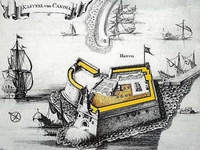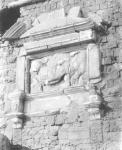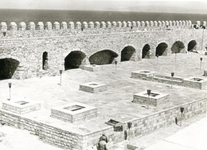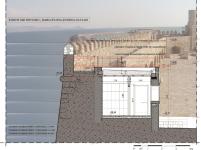

The haven of Heraklion was probably already in use as
a fortified harbor during the Hellenistic period. It was protected by a
windward breakwater from the NW and a leeward breakwater from the South. At the
eastern edge of the windward breakwater there was a beacon-tower, which was
probably reconstructed, along with the rest of the fortification enceinte, in
the 7th or 8th c. A.D., to confront with the Arab threat.
It was probably the same tower which the Venetians called Castellum Communis;
they only altered its upper part by enlarging the battlement area, according to
the western tradition, as one can see on the sketch made by Christoforo
Buondelmonti in 1415. A smaller tower, at the edge of the leeward breakwater,
depicted on engravings of the 15th c., completed the defense of the
harbor’s entrance, at least from the Venetian period on. Castellum Communis was
badly damaged by the earthquake of 1508; in 1523 it was decided to be
demolished and replaced by a fortress designed according to the principles of
the bastioned defensive system (fronte bastionato), following thus the general
planning for the city’s new
fortification enceinte, which was already decided to be constructed in
1462. Respectively, a much smaller fortress seems to have been constructed at
the edge of the leeward breakwater, as one can judge by the wooden scale model
of the harbor of the year 1614 which actually lays in the Museo Storico Navale
of Venice; the small fortress was demolished in 1936.
The
construction of the large fortress begun before 1525. Since the new building
was much larger, the existing rocky foundation had to be enlarged. To achieve
that, old ships loaded with rocks and stones transferred from the island of Dia
and the quarry of Fraskia in the gulf of Palaiokastro were plunged. A small
strong spear-shaped mole (sperone), provided with ship-bindings, was created at
the northern side. On the NW side a breakwater (porporella) was constructed.
The new fortress was called Castellum a Mare (sea-fortress) or Rocca a Mare
(rock in the sea). For the construction a large amount of limestone was used,
either reused
material of the Hellenistic fortifications or from the
nearby lime quarries. The construction was completed by the year 1540,
nevertheless it suffered constantly by the sea-weaves, a fact that forced the Venetians to plan successive restorations.
The difficulties and the problems as well as the constant suggestions for
alterations never stopped until the break of the Ottoman siege, during which
the fortress was easily defeated.
After the capture of the city in 1669, the Ottomans
made alterations to the fortress, which they called “the Fortress of the Water”
(Su Kulesi); this name prevailed until our days (Kules), its original Venetian
name being forgotten. The southern side, which had collapsed due to the canon
shuts, was reconstructed and the original straight parapet of the upper terrace
was raised, along with the surrounding corridor, and it was crowned with
battlements. At the southern side a mosque with a minaret was constructed. In
1864 the beacon of the fortress was reconstructed by the French Company for the
Ottoman Beacons. Several repairs took place during the period of the Cretan
State as well as after the unification of Crete and Greece in 1913.
 | 2. The Sea-Rock (La Rocca a Mare) | |
|---|---|---|
 | 2.2 The relief emblems of Venice | |
 | 2.3 The older restoration campaigns of the 20th c. | |
 | 2.4 The recent restoration campaign (2011-2016) |